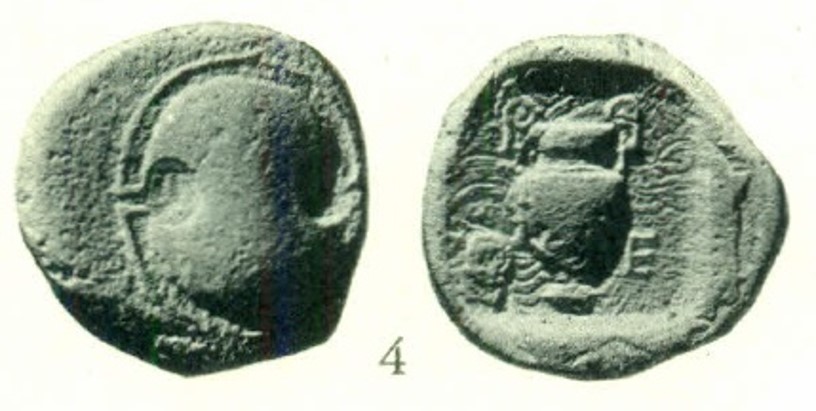SO 510 - Thebes over Pharsalus
From SILVER
(CSV import-Overstrikes-2022-08-16) |
|||
| Line 1: | Line 1: | ||
{{Overstrike | {{Overstrike | ||
| − | |Museum collection=Athens, Numismatic Museum | + | |Image overstriking coin=Thebes_shield_amphora.png.jpg |
| + | |Image reference overstriking coin=https://www.jstor.org/stable/43573328?seq=7 | ||
| + | |Image overstruck variety=Pharsale.jpg | ||
| + | |Image reference overstruck variety=https://www.jstor.org/stable/43573328?seq=7 | ||
| + | |Museum collection=Athens, Numismatic Museum | ||
|Obverse description=Boiotian shield. | |Obverse description=Boiotian shield. | ||
|Reverse legend=Θ-E | |Reverse legend=Θ-E | ||
| + | |Reverse legend language=Greek | ||
|Reverse description=Amphora within incuse square. | |Reverse description=Amphora within incuse square. | ||
|Mint=Thebes | |Mint=Thebes | ||
|Ancient region=Boeotia | |Ancient region=Boeotia | ||
| − | |Date from= | + | |Date from=425 BCE |
| − | |Date to= | + | |Date to=400 BCE |
| + | |Period=Classical | ||
| + | |Metal=Silver | ||
|Weight=10.57 | |Weight=10.57 | ||
|Denomination=Stater | |Denomination=Stater | ||
|Standard=Aeginetic | |Standard=Aeginetic | ||
| − | |Coin reference= | + | |Coin reference=Noe 1954, p. 91, pl. XIV, n°4. |
| − | |Coin series reference= | + | |Coin series reference=Babelon 1914, Noe 1954, p. 91, pl. XIV, n°4; HGC 4, n°1312 |
| + | |Coin series web reference=https://greekcoinage.org/iris/id/thebes.babelon_1914.243-50 | ||
|Overstruck obverse description=Head of Athena right, wearing crested helmet (visible: profls to right and the crest of a helmet, with hair-tresses). | |Overstruck obverse description=Head of Athena right, wearing crested helmet (visible: profls to right and the crest of a helmet, with hair-tresses). | ||
|Overstruck reverse legend=ΦΑ | |Overstruck reverse legend=ΦΑ | ||
| + | |Overstruck reverse legend language=Greek | ||
|Overstruck reverse description=Rider galopping right. | |Overstruck reverse description=Rider galopping right. | ||
|Overstruck mint=Pharsalus | |Overstruck mint=Pharsalus | ||
|Overstruck ancient region=Thessaly | |Overstruck ancient region=Thessaly | ||
| + | |Overstruck date from=425 BCE | ||
| + | |Overstruck date to=350 BCE | ||
| + | |Overstruck period=Classical | ||
| + | |Coin series reference overstruck=Noe 1954, p. 91, pl. XIV, n°5. | ||
| + | |Coin series web reference overstruck=https://greekcoinage.org/iris/id/pharsalus.lavva_2001.b.i.2-6.10.13.15.17.20 | ||
| + | |Frequency of overstrikes=frequent | ||
| + | |Level of confidence=strong | ||
}} | }} | ||
Revision as of 10:46, 24 April 2024
425 BCE - 400 BCE | Θ-E
Location/history
| Museum collectionMuseum collection: | Athens, Numismatic Museum | |
Overstriking coin
Description
| ObverseInscription or printing placed on the obverse.: | Boiotian shield. | ReverseInscription or printing placed on the reverse.: | Θ-E (Greek) Amphora within incuse square. |
Mint and issuing power
| MintIdentifies the place of manufacture or issue of a numismatic object.: | Thebes | Ancient regionAncient region. | Boeotia | Modern countryModern country: Greece | AuthorityIdentifies the issuing power. The authority can be "pretended" when the name or the portrait of X is on the coin but he/she was not the issuing power. It can also be "uncertain" when there is no mention of X on the coin but he/she was the issuing power according to the historical sources: |
Chronology
| FromIdentifies the initial date in a range assigned in a numismatic context. 425 BCE toIdentifies the final date in a range assigned in a numismatic context.. 400 BCE | Classical 480-323 BC |
Physical description
| MetalThe physical material (usually metal) from which an object is made.: Silver |
WeightWeight of the numismatic object (in grams). in grams: 10.5710.57 g <br />10,570 mg <br /> | DenominationTerm indicating the value of a numismatic object. Examples: tetradrachm, chalkous, denarius.: Stater | |
| StandardStandard.: Aeginetic | |||
References
| Coin referenceReference of the Coin: | Noe 1954, p. 91, pl. XIV, n°4. | Coin series referenceReference to coin series study: | Babelon 19141Babelon 1914, Noe 1954, p. 91, pl. XIV, n°4, HGC 42HGC 4, n°1312 |
| Coin series web referenceCoin series web references: | |||
Overstruck type
Description
| ObverseInscription or printing placed on the obverse.: | Head of Athena right, wearing crested helmet (visible: profls to right and the crest of a helmet, with hair-tresses). | ReverseInscription or printing placed on the reverse.: | ΦΑ (Greek) Rider galopping right. |
Mint and issuing power
| MintIdentifies the place of manufacture or issue of a numismatic object. ᵖ: | Pharsalus | Ancient regionAncient region. ᵖ | Thessaly | Modern countryModern country: Greece | AuthorityIdentifies the authority in whose name (explicitly or implicitly) a numismatic object was issued. ᵖ: |
Chronology
| FromIdentifies the initial date in a range assigned in a numismatic context. 425 BCE toIdentifies the final date in a range assigned in a numismatic context.. 350 BCE | Classical 480-323 BC |
Physical description
References
| Coin type referenceReference to coin series study ᵖ: | Noe 19543Noe 1954, p. 91, pl. XIV, n°5. | ||
| Coin series web reference overstruckCoin series web references overstruck: | |||
Additional data
| Frequency of overstrikesFrequency of overstrikes: | frequent | Level of confidenceLevel of confidence of the identification: | strong |
| RemarksRemarks: | |||
References
- ^ Babelon, Ernest (1914), "Traité des monnaies grecques et romaines 2, Description historique t. 3 Comprenant les monnaies de la Grèce centrale et méridionale aux Ve et IVe siècles avant J.-C.", E. Leroux, p.580
- ^ Hoover, Oliver D. (2014), Handbook of Greek Coinage Series 4. Northern and Central Greece : Achaia Phthiotis, Ainis, Magnesia, Malis, Oita, Perrhaibia, Thessaly, Akarnania, Aitolia, Lokris, Phokis, Boiotia, Euboia, Attica, Megaris and Corinthia, sixth to first centuries BC, Lancaster, lxxi, 563 p.
- ^ Noe, Sydney P. (1954), "Countermarked and overstruck Greek coins at the American Numismatic Society", American Numismatic Society. Museum notes 6, p. 85-93.

